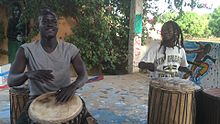Dunun

Dunun even dundun, djoundjoung, ngangan or konkonin are undoubtedly celled cylinder drums at mandingsprechenden ethnic groups in the West African Sahel - and Sudan region to which the countries of Senegal , Gambia , Guinea , Ivory Coast and Burkina Faso belong. In Manding languages , any drum can also be referred to as dunun .
Due to the widespread Djembé ensembles, named after the beaker drum djembé , a set of three differently tuned dunun bass drums is particularly well known: the large dun (d) unba , the medium-sized sangba and the small kenkeni (n) or kensedenin .
Design
Different pitches can be achieved through different sizes. In the Djembé ensemble, three differently tuned dununs form a unit.
- The dundunba has the deepest mood . Typical dimensions are 60–70 cm in length and 40–50 cm in diameter. Ba is big on Maninka so dundunba literally large Dundun means.
- The sangban or sanban stands for the middle range. Typical dimensions are 50-60 cm in length and 30-40 cm (12-16 in) in diameter.
- The kenkeni (n) is the most highly tuned bass drum. Typical dimensions are 45-50 cm in length and 25-35 cm (10-14 in) in diameter.
Often in traditional drum ensembles a wrought-iron bell called kenken is attached to the middle one , in more modern ensembles also to all three bass drums. Like the djembé , the dundun are also made from a log, but - unlike the djembé - have a continuous cylindrical cross-section, which is closed on both sides by a somewhat thicker, untanned cow , calf or goat skin stretched by a special cord system .
Style of play
Dundun are played with sticks. In the traditional technique, the lying drum with an iron bell ( kenken ) mounted on it is played by a single drummer. The interaction of several players creates a melody. In the so-called ballet style , a drummer plays a set of three standing dundun .
Dundun and sangban can also be active as a soloist, with the latter often assuming a leadership function and, for example - similar to the solo djembé - giving signals for changing dance figures.
In some dances, the high kenkeni and the middle sangban symbolize the female and the low dundun the male dance figures. Combined with different bass figures of the dundun , one and the same basic rhythms of the djembé often even get different names, according to which they are then played on different occasions.
Classic dunun rhythms of the West African Mandinka culture are called Dunungbe, Takosaba, Bandon Djeli, Taama, Gberedu, Kurabadon, Konowulen, Bolokonondo and Demussoni Kelen .
literature
- Andreas Meyer: African drums . (Publications of the Museum für Völkerkunde Berlin, New Series) Berlin 1997, ISBN 978-3-88609-275-8
- Rainer Polak: Festival music as work, drumming as a profession. Jenbe player in a major West African city. Dietrich Reimer, Berlin 2010, ISBN 978-3-496-02840-6
- Rainer Polak: Dunun. In: Laurence Libin (Ed.): The Grove Dictionary of Musical Instruments. Vol. 2, Oxford University Press, Oxford / New York 2014, pp. 199f
- Rainer Polak, Justin London: Mande ensemble drumming: An introduction to Ngòn. International Symposium on Performance Science, 2013, pp. 639–644
Web links
- Dunun . Africandrumming
- African Djembe Drummers in Paris Metro. Youtube video
Individual evidence
- ↑ Mamady Keïta . (2009). Djembe talk and performance with Mamady Keïta at the Big Bang festival in Dublin, Ireland (flv). djembefola.com. 36:50, 44:40.
- ↑ a b Dunun Styles. In: michaelpluznick.com. November 20, 2014, accessed June 7, 2017 .
- ↑ Certification Guidelines. In: djembefola.com. Retrieved June 7, 2017 .

